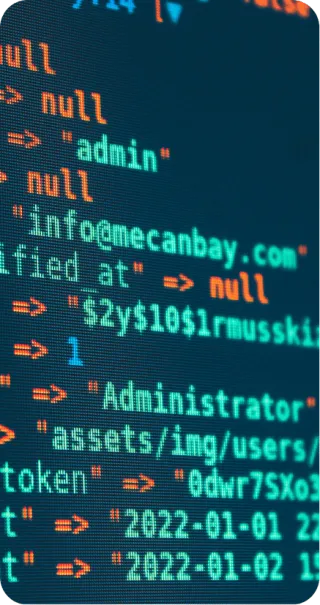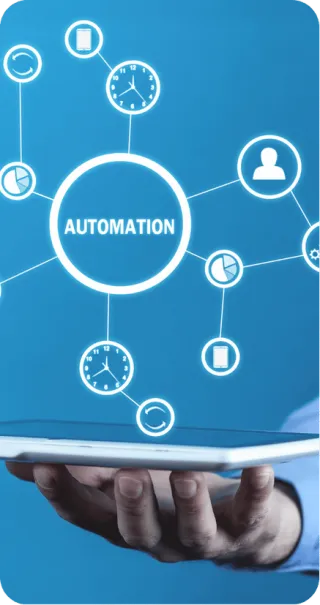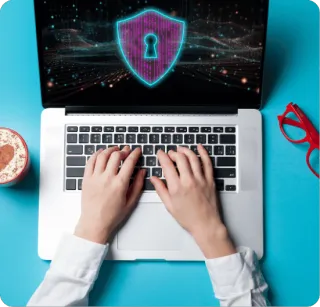Enterprise-Grade Technology & Cybersecurity Solutions for Greater Phoenix Area Businesses
Seamless operations. Zero downtime. Total peace of mind.
We keep your technology flowing.
Get A Free Consultation Today!
Book 15 minutes now — discover how to bulletproof your IT and protect your business before the next outage hits.
You don’t just need “help when stuff breaks.” You need systems that stay ahead of threats and glitches. At LiquidIT, we build and manage infrastructure and security so your team can focus on what matters — growth, clients, innovation.
Why LiquidIT?

Our Comprehensive Services
We don’t just fix problems — we prevent them. At LiquidIT, our services are designed to keep your technology flowing smoothly, securely, and without interruptions.
Cybersecurity
Protect your business from evolving digital threats with enterprise-grade cybersecurity solutions designed for small to mid-sized companies. Our managed cybersecurity services provide end-to-end protection across your entire IT environment — from endpoint defense to network monitoring and employee awareness.
We proactively detect and neutralize threats before they disrupt your business, using advanced tools like real-time intrusion detection, malware prevention, vulnerability scanning, and automated patch management. Beyond technology, we build human firewalls through ongoing security awareness training to reduce risk from phishing and social engineering attacks.
With 24/7 monitoring, threat intelligence, and rapid incident response, our team ensures your data, systems, and reputation stay protected at all times. Whether you’re meeting compliance standards or simply want peace of mind, our cybersecurity solutions provide the defense your business deserves.

Managed IT
Focus on running your business while we handle the technology that keeps it moving. Our Managed IT services provide complete, proactive management of your IT environment — ensuring your systems are secure, efficient, and always performing at their best.
We act as your dedicated IT department, delivering 24/7 monitoring, maintenance, and support for your networks, servers, workstations, and devices. From routine updates and troubleshooting to strategic IT planning, our team keeps your technology aligned with your business goals.
With our flat-rate service model, you get predictable costs and unlimited access to expert support — no surprise fees or downtime frustrations. Whether your team is in the office, remote, or hybrid, we ensure seamless connectivity, reliability, and productivity across every location.
Our Managed IT solutions are designed to minimize disruptions, prevent issues before they happen, and help your business scale with confidence.

Cloud Solutions
Empower your business with flexible, secure, and scalable cloud technology. Our Cloud Solutions make it easy to modernize your IT infrastructure, improve collaboration, and reduce costs — all while keeping your data safe and accessible from anywhere.
We design, deploy, and manage cloud environments that fit your business needs, whether that’s public, private, or hybrid. From migrating servers and applications to optimizing your Microsoft 365 or Google Workspace environments, we handle every detail to ensure a seamless transition and reliable performance.
Our cloud experts continuously monitor and maintain your systems to guarantee uptime, data security, and compliance. With built-in redundancy and advanced security measures, you’ll gain peace of mind knowing your business can operate efficiently — no matter where your team works.
Streamline operations, boost productivity, and future-proof your IT with our customized Cloud Solutions.

IT Projects
Take your technology to the next level with expertly planned and executed IT projects. Whether you’re upgrading your infrastructure, deploying new software, or expanding your network, our team delivers start-to-finish project management that minimizes downtime and maximizes results.
We specialize in designing and implementing scalable, secure, and efficient technology solutions tailored to your business goals. From server migrations and hardware refreshes to cloud integrations and cybersecurity enhancements, every project is handled with precision, transparency, and accountability.
Our certified technicians follow proven best practices to ensure every deployment is on time, on budget, and fully aligned with your operational needs. You’ll receive clear communication, milestone tracking, and post-project support to guarantee long-term success.
When your business needs more than just maintenance — it needs progress — our IT Project Services deliver the expertise and execution to make it happen.

VOIP
Transform the way your business communicates with our advanced VoIP phone systems. Designed for reliability, clarity, and flexibility, our VoIP solutions deliver enterprise-level communication at a fraction of the cost of traditional phone systems.
We provide fully managed, cloud-based phone systems that integrate seamlessly with your business tools — giving your team the freedom to make and receive calls from anywhere, on any device. Features like call routing, voicemail-to-email, auto attendants, call recording, and conferencing keep your team connected and your customers satisfied.
Our VoIP services include installation, configuration, ongoing maintenance, and user support, so you can focus on your business while we ensure your communications run smoothly. With predictable pricing, no hidden fees, and high-quality call performance, our VoIP systems are built to scale as your business grows.
Experience crystal-clear communication and smarter collaboration with our managed VoIP solutions.

AI & Automation
Work smarter, not harder. Our AI & Automation solutions are designed to streamline your operations, reduce manual tasks, and give your team back valuable time. By integrating intelligent automation into your workflows, we help your business run faster, more efficiently, and with fewer errors.
From AI-powered chatbots and automated ticketing systems to workflow automation, data processing, and predictive analytics, we tailor every solution to fit your unique business processes. Our experts ensure that your automations are secure, scalable, and seamlessly integrated with your existing IT infrastructure.
We don’t just deploy technology — we help you use it strategically. By combining artificial intelligence with automation, you gain real-time insights, improve customer experience, and eliminate repetitive bottlenecks that slow growth.
Let us help you harness the power of AI and automation to create a more productive, data-driven, and future-ready business.

Structured Cabling
Build a strong foundation for your technology with professionally designed and installed structured cabling. We create organized, high-performance network infrastructures that support your voice, data, video, and security systems — ensuring reliability, scalability, and efficiency across your entire operation.
Our certified technicians handle every aspect of cabling installation, including design, layout, labeling, and testing. Whether you’re wiring a new facility, expanding your network, or upgrading outdated infrastructure, we deliver clean, efficient, and standards-compliant cabling solutions that keep your business connected.
We use only high-quality materials and adhere to industry best practices, guaranteeing optimal performance and long-term durability. From Cat6 and fiber optics to server room setup and rack management, we ensure your network is built to handle current demands and future growth.
A dependable network starts with dependable cabling — and our structured cabling services provide the backbone your business can trust.

Industries We Serve
Every industry has unique challenges. At LiquidIT, we tailor our services to fit the needs of your business so you can stay secure, connected, and focused on growth.


Professional Services
From law firms to accounting practices, your clients rely on you for precision, speed, and confidentiality. We deliver secure file management, compliance-driven solutions, and dependable IT support to keep you productive and trusted.

Financial & Insurance
With regulatory requirements and cyber threats at an all-time high, financial institutions need airtight security and uninterrupted uptime. We deliver advanced cybersecurity, compliance support, and resilient infrastructure designed for financial operations.

Medical Practices
Patient care depends on secure, reliable technology. We provide HIPAA-compliant solutions, secure data storage, and round-the-clock IT monitoring to protect sensitive information while keeping your practice running smoothly.

Manufacturing & Industrial
Downtime costs money. We support manufacturing environments with robust network infrastructure, automation solutions, and proactive IT maintenance to keep your operations flowing without disruption.

Real Estate & Construction
Your industry moves fast. From VoIP solutions that keep your agents connected to mobile-friendly IT support for teams in the field, we ensure your technology works wherever you do.

Nonprofits & Education
Budgets are tight, but the mission matters. We deliver cost-effective IT support, cybersecurity, and cloud solutions so nonprofits and schools can serve communities without tech holding them back.

Retail & Hospitality
From point-of-sale systems to guest WiFi and online ordering, your business can’t afford downtime. We provide secure, reliable IT infrastructure and responsive support that keeps customers happy and revenue flowing.
The Advantage of Partnering With Us
When it comes to protecting your business and keeping your technology running smoothly, you deserve more than just another IT vendor — you deserve a partner who is as invested in your success as you are. Here’s the advantages of partnering with us:
Proactive, Not Reactive

We don’t wait for problems to happen — we prevent them. With 24/7 monitoring and real-time threat detection, you can focus on growth instead of worrying about downtime or cyberattacks.
Enterprise-Level Security for Every Business

Cybersecurity isn’t just for big corporations. Whether you’re a small startup or a growing enterprise, we deliver advanced protection that keeps your data, customers, and reputation safe.
Predictable, Transparent Pricing

Say goodbye to surprise IT bills. Our flat-rate, all-inclusive plans give you consistent monthly costs and unlimited support so you can budget with confidence.
A Team of Experts on Your Side

Instead of relying on one in-house IT employee, you gain access to a full team of certified professionals who specialize in networking, cloud, cybersecurity, and compliance.
Local Support with a Personal Touch

We’re not a faceless call center. Our team lives and works here in Arizona, and we pride ourselves on building long-term relationships with the businesses we serve.
Your Growth Is Our Mission

Technology should drive your business forward, not hold it back. We align every solution with your goals so you can work smarter, scale faster, and stay protected every step of the way.
Testimonials
Liquid IT is incredibly knowledgeable.Our church had been trying to get Cox to resolve a problem for nearly two years. We hired Liquid IT and they fixed the problem in a matter of days, including time to buy the parts. They have great business connections and are very responsive. We have now used their services for Office IT Support, installing superior, secure internet coverage, establishing telephone services, and are now working on a security camera upgrade. We are highly satisfied!

Liquid IT has been a game-changer for our law firm. We have been in business for over fifty years, have multiple offices and a large database. We have previously had in-house IT and worked with several IT companies over the years. Liquid IT is something different. This is an IT provider that is nimble and adaptable to company needs. Response time is amazing and expectation management and communication is like nothing we’ve experienced with other providers. If you are on the fence with choices, this is the one.

After a hard cyber attack hit my business, I was lost. That was until I was introduced to Josh at Liquid IT. Through the remediation efforts, he has been the one who has cut through what was going on, recovered computers and accounts, helped recover social accounts, explained to us what was going on, and so much more. Additionally, my home office is now setup with 24/7 monitored IT protection at a low cost that I can afford. A service I didn't even knew existed for companies of my size. Finally, Josh is not only as knowledgeable as they come, but he's also a great human being who is fun to work with through tough IT needs as well. Dare I even say, we've become friends thought it all. I would still be deep within the hack if he hadn't been a partner with me, listening to what was going on and acting on it, and I can't thank him enough for all of his help, timeliness, dedication, knowledge, and constant support. If your business needs IT help, stop looking and engage Liquid IT. I'm never using anyone else.

Our non-proft agency has used Liquid IT for over 5 years for our IT, cyber security and surveillance. The customer service is above and beyond. The proactive work, timely responses and the security oversight has benefitted our agency and our team beyond measure. The Liquid IT team communication is immediate, accurate and inclusive to all departments within our organization.

We were facing a critical six-month system breakdown that multiple companies had tried—and failed—to fix. It led to a four-day lead blackout and an estimated $80–$100K in lost revenue. At 5 PM, I reached out to Josh with Liquid IT. With very little context and information, Josh and the team jumped in immediately, worked outside business hours, resolved the issue overnight, and delivered a scalable solution within 48 hours. Their integrity, speed, and technical expertise are unmatched. If you’re looking for an IT partner who truly shows up when it matters, Josh and his team are the company you want in your corner. After 16 years in executive level operations, I’ve never worked with anyone better.

We've been working with Liquid IT for a while now, and I can't say enough great things about Josh and his team! Their expertise and quick response time have made a huge difference for our business. Whether it's technical issues or implementing new systems, they handle everything with professionalism and efficiency. Liquid IT staff are always available to answer questions and provide support, which gives us peace of mind knowing we're in good hands. I highly recommend Liquid IT for anyone looking for reliable and knowledgeable IT services!

Frequently Asked Questions
What is a Managed IT Service Provider (MSP)?
A Managed IT Service Provider (MSP) is a company that takes over the responsibility of managing and supporting your business’s technology. Instead of hiring a full in-house IT team, you can outsource to an MSP for services like 24/7 monitoring, help desk support, cybersecurity, data backup, and network management.
Why should my business use managed IT services?
Managed IT services save you time, money, and stress. With an MSP, you get access to a full team of experts at a fraction of the cost of hiring internally. This means fewer tech headaches, stronger security, faster problem resolution, and the ability to scale IT as your business grows.
How do managed IT services improve cybersecurity?
MSPs continuously monitor your systems, patch vulnerabilities, and protect against threats like ransomware, phishing, and data breaches. They also provide proactive security audits and employee training to minimize human error — one of the biggest risks to businesses today.
Can you work with my existing IT staff?
Yes. Many businesses have in-house IT personnel and use an MSP to supplement their capabilities. We can handle day-to-day monitoring, security, and help desk support while your internal team focuses on strategy and innovation.
What industries do you specialize in?
We work with a wide range of industries, including healthcare, finance, legal, manufacturing, retail, and professional services. Our solutions are customized to meet compliance standards and unique challenges within each sector.
How much do managed IT services cost?
Pricing depends on the size of your business, the complexity of your systems, and the level of support you need. Most MSPs offer predictable, flat-rate monthly pricing — so you’ll know exactly what to budget each month with no surprises.
Dedicated To Your Success
There are only two types of companies: those that have been hacked and know it, and those that have been hacked and don’t know it yet. The challenge is not just preventing the attack, but preparing your business to survive and thrive afterward.

From Our Founder

Josh Jaloweic, CEO
Liquid IT was founded with a clear mission: to give businesses smarter, faster IT services without the confusion, delays, or waste that too often come with outsourced support. From day one, we believed in doing things differently—by listening more, fixing issues before they spread, and staying laserfocused on delivering long-term value.
Instead of just throwing bodies at problems, we built a team that thrives on strategy, automation, and simplicity. Our approach delivers real results for clients who want fewer headaches, faster support, and a partner who’s truly invested in their growth.
With over 30 years navigating enterprise IT complexities—from operations management to leading technical transformations— I founded Liquid IT after experiencing the frustrations of traditional support models firsthand. Every solution we implement is designed not just to solve today's problems, but to position your business for sustainable growth.
When you partner with us, you're not just getting technical support— you're gaining a team that understands how technology should work seamlessly behind the scenes, allowing you to focus entirely on what drives your business forward.
Insights & Expertise
Why Cloud Data Protection Matters for Your Business
Cloud data protection is the mix of technical controls and operational practices that stop data loss, theft, corruption, or unauthorized access across cloud environments. ...more
IT
November 26, 2025•16 min read

Emerging Cyber Threats in the Digital Age
New cyber threats combine advanced attacker tools with a bigger, more connected surface — and that creates outsized risk for small and mid-sized businesses (SMBs). ...more
IT
November 21, 2025•14 min read

What Are Effective Cyber Threat Detection Methods
Cyber threat detection is the combination of tools, processes, and human practices used to spot malicious activity across networks, endpoints, cloud services, and user accounts. ...more
IT
November 17, 2025•14 min read

Let's Build Something That Lasts
Tailored IT Support & Cybersecurity Services
Focused On Your Business Success
Let's start a partnership that prioritizes your goals, reduces tech issues,
and delivers dependable resuts through fast, strategic IT services.

COMPANY
CUSTOMER CARE
LEGAL
SALES INQUIRIES
FOLLOW US
Copyright 2025. LiquidIT. All Rights Reserved. Designed by CNC Marketing Group.






